Epoxy curing agents based on cycloaliphatic diamines are typically used for coating applications that require low color, good color stability, long open time and good resistance to amine blush (or carbamation). Other desirable properties include high hardness values, good mechanical properties and resistance to chemicals such as alkalis and dilute acid solutions. An undesirable phenomenon that can occur with an epoxy coating cured using a cycloaliphatic diamine-based curing agent is amine blush. Amine blush can occur under a variety of cure conditions, but becomes more likely as the ambient temperature decreases and/or as the relative humidity increases. It should be noted that aliphatic diamines tend to have a higher blushing tendency than cycloaliphatics. Aromatic diamines have the least tendency toward blushing, however they are usually dark in color and many are toxic.
Curing agents containing cycloaliphatic diamines are commonly used in a variety of applications for which epoxy systems are well-suited. Examples include those used as coatings, primers or sealers on a variety of substrates, such as concrete and metal used on floors, walls, tanks, pipes, etc. Cycloaliphatic diamines are also desirable for monolithic, or seamless, epoxy floorings such as self-leveling, broadcast and mortars. As one could expect, different cycloaliphatic diamines offer different advantages and limitations.
There are a number of cycloaliphatic diamines that can be used as curing agents for epoxy resins, but relatively few are commonly used in the coatings industry. These include 1,2-diaminocyclohexane (DACH), bis(p-aminocyclohexyl)methane (PACM) and 1,3-bis(aminomethyl)cyclohexane (1,3-BAC), but the most commonly used is isophorone diamine (IPD). These diamines are used as building blocks to create a finished curing agent. A summary of their general performance properties when used to cure an epoxy resin is listed in Table 1.
The diamines can be modified in various ways to overcome many of their limitations to approach the desired level of performance for the intended application. There are many applications that require the high chemical resistance and good mechanical properties of epoxy systems as well as good aesthetic properties such as consistent color development, minimal color change over time and high gloss. Preferably, a room painted a certain color should stay that color for as long as possible. Resisting a gradual change in color over time is not a strength of epoxy systems due to their chemical nature; however cycloaliphatic diamine-based curing agents are best suited for the job. The coating should also withstand aggressive cleaning solutions and cleaning with steam or hot water. As suggested in Table 1, IPD offers many of the desired properties for the aforementioned uses and, consequently, it is the most commonly used cycloaliphatic diamine for epoxy curing agents. These IPD-based curing agents represented the state-of-the-art − until recently.
New Curing Agent
The development of a unique technology has provided the means to improve upon the performance offered by IPD-based curing agents. Aradur® 2978 epoxy curing agent was designed to address the need for higher performance and increased productivity. It does not contain -bisphenol‑A, phthalates or solvents. This novel epoxy curing agent improves upon the current state-of-the-art technology by offering some important advantages. As detailed in Table 2, Aradur 2978 has a lower viscosity than typical IPD-based curing agents, leading to a lower viscosity of the mixed binder, which allows for higher filler loadings. For simplicity of replacement, the usage level of this new epoxy curing agent is equivalent to the latter.
The typical performance properties that are important to formulators of epoxy systems intended for architectural applications are varied. Some of the most common are listed in Table 3.
Comparatively, Aradur 2978 out-performs conventional IPD-based curing agents in many aspects. A key benefit is its longer pot life (or working time) and equivalent thin-film curing speed − a unique combination in two-component ambient-curing epoxies. This ideal combination greatly extends the time available to apply the coating, as the rate of viscosity increase is substantially slower. As depicted in Figure 1, Aradur 2978 in combination with a liquid epoxy resin (having an equivalent weight of 188 g/eq.) maintains a low viscosity for about 75 min compared to only 25 min for a similar curing agent based upon IPD. This longer window of time to apply the coating can have a dramatic effect on the reduction of waste and cost associated with discarding material that is unusable due to the rapid gelation of a typical IPD-based system.
In a solvent-free system, a large increase in working time is theorized to be the result of reduced reactivity of the curing agent; one would expect the thin film cure speed to be slower as well. However, Aradur 2978 epoxy curing agent does not suffer from low reactivity, as it offers a similar thin-film curing speed compared to IPD-based curing agents. In addition, the development of hardness is similarly rapid, reaching a shore D hardness of about 81 after 24 h of cure and 85 after seven days.
Coatings based on Aradur 2978 offer outstanding visual attributes, making it ideal for applications that require a low color with a high degree of color stability. Artificial weathering tests were performed by exposing the coating to UV-A radiation at 50 °C for a period of seven days. In this testing, a clear coating prepared using Aradur 2978 has considerably less yellowing, and better gloss retention, than that made using an IPD-based curing agent (Figure 2).
Exposure to low ambient temperature and high humidity during cure will frequently result in amine blush evidenced by poor gloss and/or a tacky surface after the coating is cured. Problems associated with blushing are difficult to correct, and removal and re-coating of the substrate may be required − a costly solution. Coatings based on Aradur 2978 can obtain a high-gloss finish even under less-than-ideal conditions. These coatings retain up to 95 percent of their typical gloss even when cured at 10 °C (50 °F) and 70 percent relative humidity. In situations that require coatings be applied in an open, or unfinished structure, the ability of coatings cured with Aradur 2978 to resist marring from water spray after only 8-9 h of cure can prove instrumental in keeping a project on schedule. Additionally, these coatings can be submerged in water after 24 h of cure without change in appearance.
Conclusion
For two-component, solvent-free epoxy coatings, Aradur 2978 offers an ideal combination of long pot life with rapid cure speed, lower neat and mixed viscosity, good color stability and superior gloss-retention properties. The rapid development of its properties allows its coatings to be unaffected by exposure to water spray soon after application and immersion in water after only 24 h. Comparatively, coatings cured with IPD-based curing agents typically require 2-3 days of cure to resist marring or staining by water spray.
Its rapid hardness development, high mechanical properties and good resistance to chemicals make Aradur 2978 useful for decorative floor toppings such as clear sealers and stone carpets, and for monolithic floorings such as broadcast, mortars and self-leveling floors. The improvement in performance properties of coatings prepared using this new epoxy curing agent can provide an easy and cost-effective option for many applications. Its performance advantages in comparison to epoxy systems cured using IPD-based curing agents are summarized in Table 4.
This paper is based on a presentation given at the 30th Biennial Western Coatings Symposium, October 23-26th 2011, Las Vegas, NV.

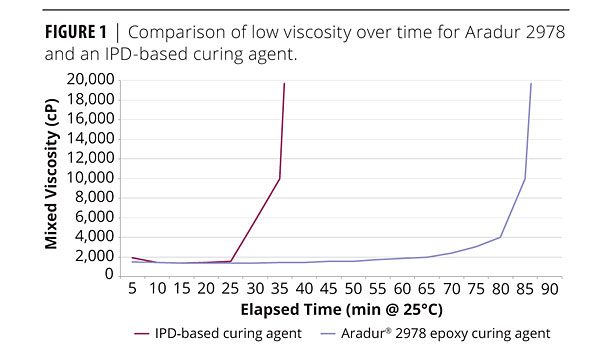

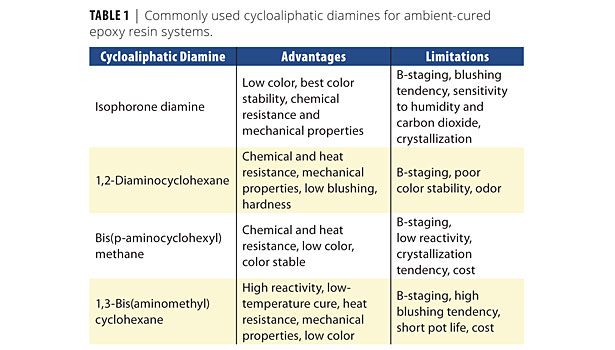

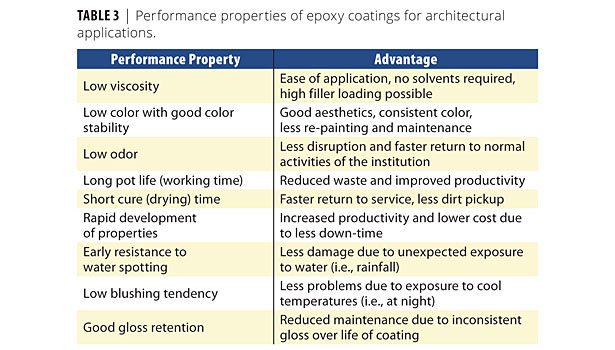
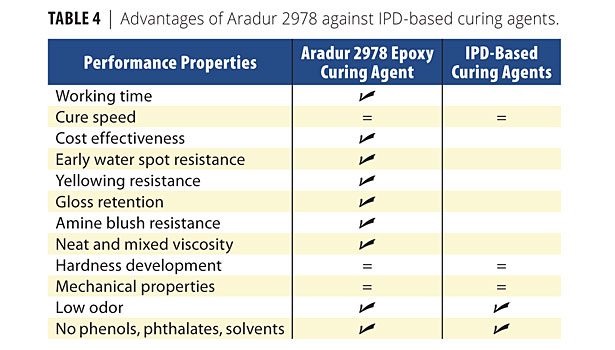
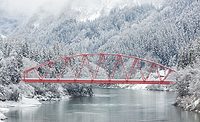
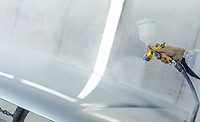
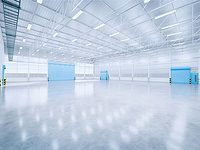

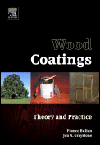
Report Abusive Comment